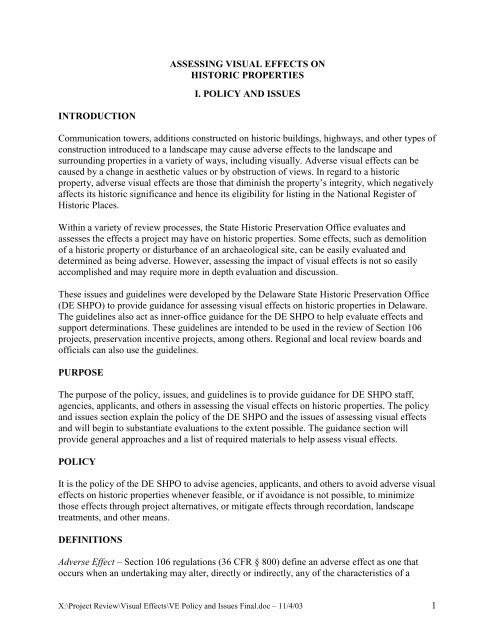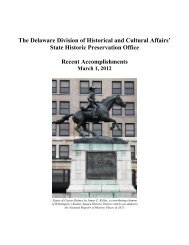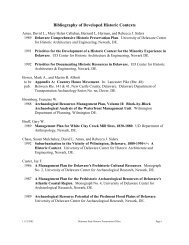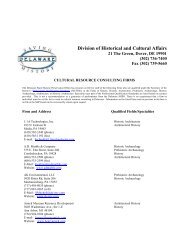Assessing Visual Effects - Delaware Division of Historical and ...
Assessing Visual Effects - Delaware Division of Historical and ...
Assessing Visual Effects - Delaware Division of Historical and ...
Create successful ePaper yourself
Turn your PDF publications into a flip-book with our unique Google optimized e-Paper software.
ASSESSING VISUAL EFFECTS ON<br />
HISTORIC PROPERTIES<br />
I. POLICY AND ISSUES<br />
INTRODUCTION<br />
Communication towers, additions constructed on historic buildings, highways, <strong>and</strong> other types <strong>of</strong><br />
construction introduced to a l<strong>and</strong>scape may cause adverse effects to the l<strong>and</strong>scape <strong>and</strong><br />
surrounding properties in a variety <strong>of</strong> ways, including visually. Adverse visual effects can be<br />
caused by a change in aesthetic values or by obstruction <strong>of</strong> views. In regard to a historic<br />
property, adverse visual effects are those that diminish the property’s integrity, which negatively<br />
affects its historic significance <strong>and</strong> hence its eligibility for listing in the National Register <strong>of</strong><br />
Historic Places.<br />
Within a variety <strong>of</strong> review processes, the State Historic Preservation Office evaluates <strong>and</strong><br />
assesses the effects a project may have on historic properties. Some effects, such as demolition<br />
<strong>of</strong> a historic property or disturbance <strong>of</strong> an archaeological site, can be easily evaluated <strong>and</strong><br />
determined as being adverse. However, assessing the impact <strong>of</strong> visual effects is not so easily<br />
accomplished <strong>and</strong> may require more in depth evaluation <strong>and</strong> discussion.<br />
These issues <strong>and</strong> guidelines were developed by the <strong>Delaware</strong> State Historic Preservation Office<br />
(DE SHPO) to provide guidance for assessing visual effects on historic properties in <strong>Delaware</strong>.<br />
The guidelines also act as inner-<strong>of</strong>fice guidance for the DE SHPO to help evaluate effects <strong>and</strong><br />
support determinations. These guidelines are intended to be used in the review <strong>of</strong> Section 106<br />
projects, preservation incentive projects, among others. Regional <strong>and</strong> local review boards <strong>and</strong><br />
<strong>of</strong>ficials can also use the guidelines.<br />
PURPOSE<br />
The purpose <strong>of</strong> the policy, issues, <strong>and</strong> guidelines is to provide guidance for DE SHPO staff,<br />
agencies, applicants, <strong>and</strong> others in assessing the visual effects on historic properties. The policy<br />
<strong>and</strong> issues section explain the policy <strong>of</strong> the DE SHPO <strong>and</strong> the issues <strong>of</strong> assessing visual effects<br />
<strong>and</strong> will begin to substantiate evaluations to the extent possible. The guidance section will<br />
provide general approaches <strong>and</strong> a list <strong>of</strong> required materials to help assess visual effects.<br />
POLICY<br />
It is the policy <strong>of</strong> the DE SHPO to advise agencies, applicants, <strong>and</strong> others to avoid adverse visual<br />
effects on historic properties whenever feasible, or if avoidance is not possible, to minimize<br />
those effects through project alternatives, or mitigate effects through recordation, l<strong>and</strong>scape<br />
treatments, <strong>and</strong> other means.<br />
DEFINITIONS<br />
Adverse Effect – Section 106 regulations (36 CFR § 800) define an adverse effect as one that<br />
occurs when an undertaking may alter, directly or indirectly, any <strong>of</strong> the characteristics <strong>of</strong> a<br />
X:\Project Review\<strong>Visual</strong> <strong>Effects</strong>\VE Policy <strong>and</strong> Issues Final.doc – 11/4/03 1
historic property that qualify the property for inclusion in the National Register in a manner that<br />
would diminish the integrity <strong>of</strong> the property's location, design, setting, materials, workmanship,<br />
feeling, or association. Consideration shall be given to all qualifying characteristics <strong>of</strong> a historic<br />
property, including those that may have been identified subsequent to the original evaluation <strong>of</strong><br />
the property's eligibility for the National Register. Adverse effects may include reasonably<br />
foreseeable effects caused by the undertaking that may occur later in time, be farther removed in<br />
distance or be cumulative (36 CFR § 800.5(a)(1)). One example <strong>of</strong> an adverse effect is the<br />
introduction <strong>of</strong> visual, atmospheric or audible elements that diminish the integrity <strong>of</strong> the<br />
property's significant historic features (36 CFR § 800.5(a)(2)(v));<br />
Additionally, the Secretary <strong>of</strong> the Interior’s St<strong>and</strong>ards for Rehabilitation states that to protect the<br />
historic integrity <strong>of</strong> a historic property <strong>and</strong> its environment, <strong>and</strong> therefore prevent an adverse<br />
effect, its historic character shall be retained <strong>and</strong> new work shall be differentiated from the old<br />
<strong>and</strong> shall be compatible with the massing, size, scale, <strong>and</strong> architectural features.<br />
Adverse <strong>Visual</strong> Effect – occurs when the undertaking’s visual impact has a negative effect on the<br />
historic property as determined through the aesthetic effects <strong>and</strong> obstructive effects outlined<br />
below [See Evaluation <strong>and</strong> Guidelines to Determine <strong>Visual</strong> Impacts].<br />
Aesthetic effect – occurs when there is an effect on the perceived beauty <strong>of</strong> a place or structure.<br />
Adverse aesthetic effects on historic properties are those that impair the character or quality <strong>of</strong> a<br />
historic property, <strong>and</strong> thus cause a diminishment <strong>of</strong> the enjoyment <strong>and</strong> appreciation <strong>of</strong> the<br />
property.<br />
Historic Property – Any prehistoric or historic district, site, building, structure, or object<br />
included in, or eligible for inclusion in the National Register <strong>of</strong> Historic Places (36CFR §<br />
800.16(1)).<br />
L<strong>and</strong>scape – Natural <strong>and</strong> manmade environment.<br />
Obstructive effect – occurs when the proposed project obstructs any part <strong>of</strong> a historically<br />
significant property or scenic view from the viewpoint <strong>of</strong> the historic property. Adverse<br />
obstructive effects on historic properties are those that obstruct in whole or part <strong>of</strong> the property<br />
<strong>and</strong> that cause a diminishment <strong>of</strong> the property’s historic character.<br />
Scenic Resources – consist <strong>of</strong> natural <strong>and</strong> manmade features <strong>and</strong> include wetl<strong>and</strong>s, bays,<br />
waterways, forests, open l<strong>and</strong>, rural areas, historic architecture, archaeology sites, urban areas,<br />
among other cultural, natural, <strong>and</strong> manmade features.<br />
Scenic View – for purposes <strong>of</strong> this document, a scenic view is the individual or collection <strong>of</strong><br />
scenic resources that are visually <strong>and</strong> aesthetically valued <strong>and</strong> that contribute to a historic<br />
property’s significance. The scenic view should be identified in the evaluation.<br />
Viewshed – area that is visible from a specified location or locations.<br />
X:\Project Review\<strong>Visual</strong> <strong>Effects</strong>\VE Policy <strong>and</strong> Issues Final.doc – 11/4/03 2
<strong>Visual</strong> effect – visual effect is present when the proposed object is viewable from a historic<br />
property. A visual effect may be beneficial or adverse <strong>and</strong> may affect the historic property in an<br />
aesthetic or obstructive manner. The determination that a visual effect exists does not<br />
automatically imply that the effect is adverse.<br />
ISSUES OF VISUAL EFFECTS AND HISTORIC PROPERTIES<br />
Due to the fact that visual effects cannot be measured <strong>and</strong> may not harm the elements <strong>of</strong> a<br />
historic property in a physical manner, assessing visual effects on historic properties can be<br />
difficult <strong>and</strong> is subjective. A historic property is affected when its historic significance <strong>and</strong><br />
integrity has been diminished. Therefore, determining how a project harms a property’s historic<br />
significance <strong>and</strong> integrity is essential to the assessment.<br />
Subjectivity<br />
The introduction <strong>of</strong> a new feature to a l<strong>and</strong>scape can create visual effects, which may be positive<br />
or negative. The assessment <strong>of</strong> visual effects is subjective. Attempting to apply a set <strong>of</strong><br />
quantitative rules for assessment is impossible because <strong>of</strong> the subjectivity <strong>and</strong> the differences<br />
between each project <strong>and</strong> property; though quantitative <strong>and</strong> qualitative data may be useful in<br />
describing the nature <strong>of</strong> the effect. In assessing the visual effects for historic properties, the<br />
criteria for significance <strong>and</strong> the aspects <strong>of</strong> integrity are factors that require evaluation <strong>and</strong><br />
provide a fairly qualitative method for determining visual effects on historic properties.<br />
Historic Significance <strong>and</strong> Integrity<br />
Historic properties convey their significance through their integrity. The aspects <strong>of</strong> integrity are:<br />
location, design, setting, materials, workmanship, feeling, <strong>and</strong> association. During review <strong>of</strong><br />
projects taking place on or near a historic property, consideration <strong>of</strong> the criteria in which the<br />
property was determined historically significant <strong>and</strong> evaluation <strong>of</strong> whether the introduction <strong>of</strong> the<br />
new feature will adversely affect the property’s integrity aspects are critical.<br />
Simply being visible from the historic property may not cause an adverse effect. Therefore,<br />
whether or not the new feature is located on the historic property, it is necessary to evaluate the<br />
changes <strong>and</strong> alterations the new feature will introduce, physically <strong>and</strong> visually, to the historic<br />
property. In addition, the changes the project may cause to the total l<strong>and</strong>scape are important<br />
factors in assessing the historic property’s relationship to its setting, which may include the<br />
property’s surrounding features <strong>and</strong> open space.<br />
ADVERSE VISUAL EFFECTS<br />
In general, a project can result in an adverse visual effect to a l<strong>and</strong>scape if it:<br />
1. Creates a demonstrable negative aesthetic effect by diminishing the existing visual<br />
aesthetics through 1) elimination <strong>of</strong> open space or a scenic view, or 2) through<br />
introduction <strong>of</strong> a visual element that is incompatible, out <strong>of</strong> scale, in great contrast, or<br />
out <strong>of</strong> character with the surrounding area <strong>and</strong> the aesthetics or character; or<br />
X:\Project Review\<strong>Visual</strong> <strong>Effects</strong>\VE Policy <strong>and</strong> Issues Final.doc – 11/4/03 3
2. Creates an obstructive effect by 1) blocking or intruding into a scenic view; 2)<br />
blocking a significant feature <strong>of</strong> the scenic view; 3) blocking another listed historic<br />
property viewed from the subject historic property; or 4) providing a visual element<br />
that would detract from a scenic view or historic property.<br />
A project results in an adverse visual effect to a historic property if the aesthetic or obstructive<br />
effects diminish the integrity <strong>of</strong> the property's location, design, setting, materials, workmanship,<br />
feeling, or association, which are characteristics that qualify the property for inclusion in or<br />
eligibility for the National Register <strong>of</strong> Historic Places.<br />
Aesthetic <strong>Effects</strong> on Historic Properties<br />
Whether a project is located on or near a historic property, it can change the visual appreciation<br />
<strong>of</strong> a l<strong>and</strong>scape <strong>and</strong> possibly diminish a property’s historic integrity. Adverse aesthetic effects are<br />
determined on a case by case basis considering the following factors:<br />
1. Property’s historic significance. It is necessary to underst<strong>and</strong> the property’s historic<br />
significance <strong>and</strong> integrity in order to evaluate the project’s effects on the property’s<br />
eligibility for listing in the National Register <strong>of</strong> Historic Places.<br />
2. The existing visual features at the project location (located <strong>of</strong>f the historic property).<br />
The alteration <strong>of</strong> the features at the project location, including open space, can affect<br />
the view from the historic property <strong>and</strong> possibly the location, feeling, setting, <strong>and</strong><br />
association <strong>of</strong> the historic property. This includes the amount or proportion <strong>of</strong><br />
existing features or elements that would be removed, altered, or demolished <strong>and</strong> that<br />
contribute to the visual character or image <strong>of</strong> the neighborhood, community, or<br />
localized area that is viewed from the historic property, <strong>and</strong> that which affects the<br />
historic property’s integrity.<br />
3. The existing visual features <strong>of</strong> the historic property. The alterations caused to the<br />
historic property <strong>and</strong> its resources can affect the view <strong>of</strong> the historic property <strong>and</strong><br />
possibly the location, feeling, setting, <strong>and</strong> association <strong>of</strong> the historic property. This<br />
includes the amount or proportion <strong>of</strong> existing features or elements that would be<br />
removed, altered, or demolished <strong>and</strong> that contribute to the visual character or image<br />
<strong>of</strong> the property, neighborhood, community, or localized area with which the property<br />
is associated. In addition, the physical changes could affect the historic property’s<br />
design, workmanship, <strong>and</strong> materials.<br />
4. The compatibility <strong>of</strong> the proposed project. Whether in an open space or a developed<br />
area, the compatibility <strong>of</strong> the project is important to the character <strong>of</strong> the project<br />
location <strong>and</strong> surrounding area, including historic properties. The character <strong>of</strong> the<br />
existing l<strong>and</strong>scape <strong>and</strong> architectural features should be the basis for determining the<br />
appropriate characteristics <strong>of</strong> the proposed project. The compatibility <strong>of</strong> the project is<br />
determined by:<br />
a. mass – the arrangement <strong>of</strong> the project’s spaces;<br />
b. scale <strong>and</strong> proportion – the size <strong>and</strong> proportion <strong>of</strong> the project to the<br />
surrounding structures <strong>and</strong> features ;<br />
X:\Project Review\<strong>Visual</strong> <strong>Effects</strong>\VE Policy <strong>and</strong> Issues Final.doc – 11/4/03 4
c. height – sometimes it may be necessary that a project height extend beyond<br />
that <strong>of</strong> the surrounding buildings <strong>and</strong> other features within view <strong>of</strong> the project.<br />
It is important that the height <strong>of</strong> the project does not cause the line <strong>of</strong> sight to<br />
move so far up that the surrounding features are out <strong>of</strong> view, thereby<br />
detracting from the original view;<br />
d. shadows;<br />
e. color;<br />
f. the degree to which the project would contribute to the area’s aesthetic value;<br />
g. the degree <strong>of</strong> contrast, or lack there<strong>of</strong>, between the project <strong>and</strong> the<br />
background, surrounding scenery, or neighborhood; <strong>and</strong><br />
h. the amount <strong>of</strong> open space.<br />
Obstructive <strong>Effects</strong> on Historic Properties<br />
Whether a project is located on or near a historic property, it can block the historic property from<br />
being viewed or block a view seen from the historic property; thereby possibly diminishing the<br />
property’s integrity. Determination <strong>of</strong> adverse obstructive effects shall be made on a case by case<br />
basis considering the following factors:<br />
1. Property’s historic significance. It is necessary to underst<strong>and</strong> the property’s historic<br />
significance <strong>and</strong> integrity in order to evaluate the project’s effects on the property’s<br />
eligibility for listing in the National Register <strong>of</strong> Historic Places.<br />
2. Nature <strong>and</strong> quality <strong>of</strong> the view from the historic property. This includes such features<br />
as natural topography, settings, man-made or natural features <strong>of</strong> visual interest, <strong>and</strong><br />
historic properties seen from the historic property <strong>and</strong> that which contribute to the<br />
historic property’s significance <strong>and</strong> integrity.<br />
3. Extent <strong>of</strong> obstruction. This includes total blockage, partial interruption, or<br />
diminishment <strong>of</strong> a person’s enjoyment <strong>and</strong> appreciation <strong>of</strong> a scenic view or listed<br />
historic property viewed from the historic property, <strong>and</strong> that affects the integrity <strong>of</strong><br />
the historic property.<br />
4. Obstruction <strong>of</strong> a historic property. The project might obstruct the historic property<br />
from being viewed from the project site or other area. If the historic property is<br />
visually appreciated from surrounding viewpoints, obstructing its view may affect its<br />
feeling, setting, location, or association.<br />
X:\Project Review\<strong>Visual</strong> <strong>Effects</strong>\VE Policy <strong>and</strong> Issues Final.doc – 11/4/03 5









